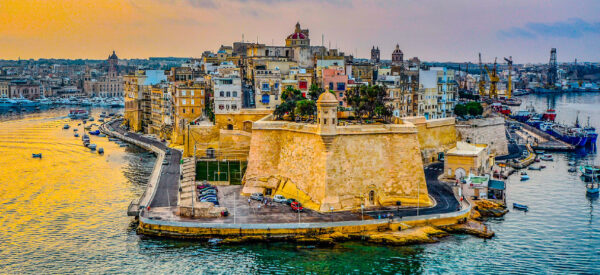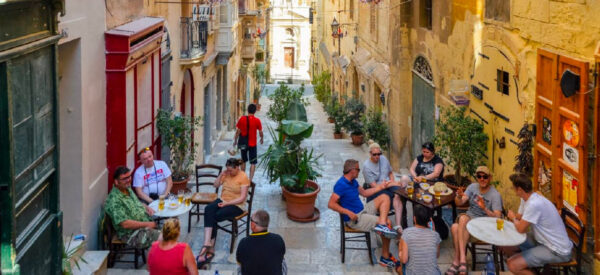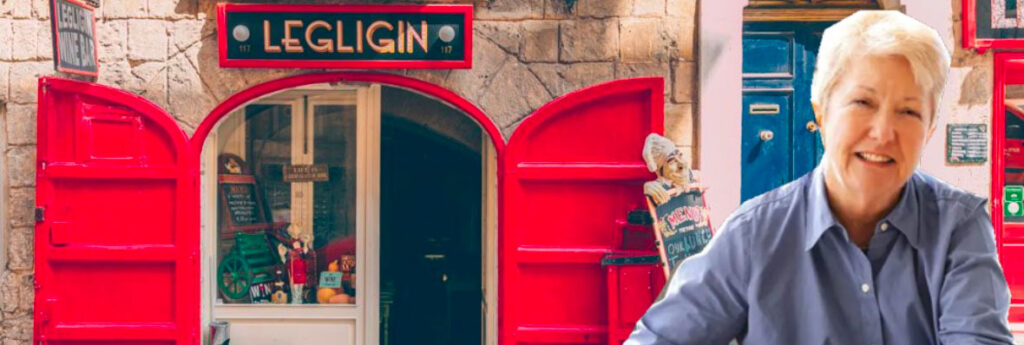I knew nothing about Malta when I decided to go last May. Friends were renting an 11-bedroom/11 bath Airbnb with a pool just outside the capital, Valletta. They were going for SIETAR, a conference on intercultural education. I went because, well, I had never been to Malta – and, at US $350 for 7 nights, housing was very “cost-effective.”
Google revealed Malta is a collection of three islands – Malta, Gozo and Comino. Until 1964, Malta was a British territory, serving as a critical supply transfer point between Western Europe and Northern Africa during World War II. Red English-style telephone booths now serve as decorative reminders, as does the mammoth statue of Queen Victoria that commands Republic Square. Malta is also the only place the late Queen Elizabeth has lived outside the UK – while Prince Phillip was posted there in 1949-1951.
Due to its colonial history, English is universally spoken in Malta. The public health system reflects the British model and is considered among the best in the world, according to WHO ratings of public healthcare. With approximately half a million residents, Malta is both the smallest and the most densely populated member of the European Union. The International Monetary Fund and World Bank categorize Malta as an “advanced economy” and “high wealth” nation. Tourism is one of the country’s top income-generating activities.

Like a kaleidoscope, what you experience in Malta depends on the lens you use.
For sun-worshippers, Malta’s tourism department promises 360 days of blue skies and a Mediterranean Sea coast that alternates between sandy beaches and picturesque limestone cliffs. I took a 7-hour Viator tour to the Blue Lagoon, Crystal Cove, and the islands of Gozo and Comino for €30. You can add land tours on Gozo for about €70 or drive yourself around the island for €115 at the time of this writing.
Another day I took the Gozo Fast Ferry for €7.5 each way between Valletta to Mgarr, Gozo’s main terminal. I used public transport to the main town, Victoria, as well as Gharb (pronounced “arb”) to visit newly-met expat friends. Public transport is €2 for a bus pass that includes transfers within a 2-hour window. Busses are air-conditioned and riders included an interesting mix of locals and tourists. There is a tourist hop-on-hop-off bus for €20, too.
History hounds can explore UNESCO Cultural sites like the Ggantija Temples on Gozo Island that predate the Egyptian pyramids and Stonehenge by 1,000 years. The archeological digs were extensively documented but couldn’t explain how the inhabitants created such mammoth structures. On the main island, Mdina and Rabatt are adjoining cities with historic buildings and views. Walking through them without a tour guide wasn’t very educational; my fault for not doing more homework.
Food is my personal travel priority as a way to get to know a country’s culture. The 3½ -hour food and walking tour of Valletta led by Christian of Viator Tours (€45) was among the best I’ve experienced anywhere. Bring a robust appetite – and/or a take-away bag! We started with an empanada-like pastizzi filled with ricotta cheese, as well as the British-inspired mushy peas version. Mushy peas, accented with curry, got my vote. Maltese date paste flash-fried in phyllo came next; think fig newtons in an off-the-charts incarnation. Lunch included tuna-stuffed olives, sausages, goat cheese and ftira biz-zejt sandwiches of meat and sundried tomatoes. Cisk beer is a local mainstay but Ulysses wine is a worthy alternative, especially the white. Twistees may be the Cheetos-like national snack, but it was the 4th-generation family-owned Chocolate District shop that made me want to declare dual citizenship. The goat cheese and olive oil chocolate was shockingly good, even while their Maltese coffee brew, heavy on clove, anise and chicory, was not to my taste.
 There are several Michelin-starred restaurants in Valletta, all of which require reservations … unless you make friends with those who already have them. AJ and Freddy, from the morning tour, had planned ahead and booked Legligin, which offers an eight-course tasting menu built around what is available on that day’s local market. Each course excellent, served stylishly on mismatched plates in a genial ambiance. The pumpkin soup, rabbit stew and quail were the most memorable for me as we spent three hours eating, talking and drinking Ulysses white wine. The cost struck me as a bargain at €38.5 each, plus wine.
There are several Michelin-starred restaurants in Valletta, all of which require reservations … unless you make friends with those who already have them. AJ and Freddy, from the morning tour, had planned ahead and booked Legligin, which offers an eight-course tasting menu built around what is available on that day’s local market. Each course excellent, served stylishly on mismatched plates in a genial ambiance. The pumpkin soup, rabbit stew and quail were the most memorable for me as we spent three hours eating, talking and drinking Ulysses white wine. The cost struck me as a bargain at €38.5 each, plus wine.
Like every 7,000-year old culture, Malta has scores of ornate cathedrals, monuments and statues. Malta also boasts three signature buildings in Valletta by Italian architect Renzo Piano. The city entrance gate, completed in 2014, is a stark departure from the previous four versions. Piano’s gate consists of stainless steel “spears” positioned to represent soldiers at “present arms,” welcoming all who cross a wide esplanade into the heart of Valletta.
Piano’s Parliament House is a boxy office building of limestone set upon thin columns. Fossils embedded in the Maltese stone add an iridescent sheen. The imposing offices and slender columns are said to reflect Piano’s vision of democracy as a heavy responsibility that rests on the support of individual voters.
Valletta’s classically-designed Royal Opera House was almost completely destroyed during World War II. Piano’s design, completed in 2013, is open-air. Instead of a roof, curved wood panels are suspended above the stage for acoustics. The building looks incomplete, especially since a chain-link barrier surrounds the rear of the theater. Local sentiment does not favor such a drastic revisioning, and there are rumors that the space will be enclosed and roofed, obliterating Piano’s version.
A little-known aspect of Malta’s appeal is medical tourism. According to Health-Tourism.com, 15% of the annual GDP (gross domestic product) flows from visitors who recover from low-cost cosmetic surgeries in a high-enjoyment atmosphere. Health-tourism.com also cites posts charts comparing fees for surgeries like tummy tucks, eyelid lifts, dental implants and breast augmentations with the cost in other countries. None of the hospitals in Malta are accredited by the Joint Commission International, a US-based nonprofit that offers voluntary evaluations. Approximately 1,000 hospitals are JHI accredited worldwide, in addition to 22,000 US-based facilities. The Maltese government has identified medical tourism as a strategic priority as part of its campaign to increase tourism-based revenue.
Would I return to Malta? Perhaps.
The harbors are beautiful, and I loved the Mediterranean cuisine. I felt safe walking alone during the day and appreciated the range of things to do without “breaking the bank.” Uber-like Bolt taxis made it easy to get around when public transport wasn’t efficient, like at night. Temperatures were significantly hotter than what Googling led me to expect, but packing to “layer” made the adjustment easy. In 2023, Carnevale will be held in February, the traditional timing. If I lived in a cold climate, the promise of warm temperatures and vibrant celebrations might well bring me back!

